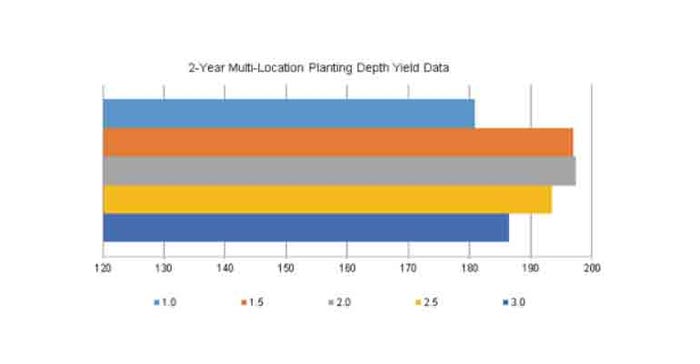April 1, 2017

Sponsored Content
Each year Beck’s Practical Farm Research (PFR) conducts multiple replicated research plots across their six sites throughout the Midwest. These plots are used to test new products and equipment in the marketplace, as well as different management practices to better define the most profitable options available to farmers. In 2016, corn planting depth studies were conducted at both the Indiana and Southern Illinois PFR sites. The data from these 2016 corn studies showed that 2.0 inches is the ideal planting depth. Beck’s two-year, multi-location PFR data has provided similar results, showing that planting within that 2.0 in. range is the most profitable. Similarly, Beck’s PFR continued their soybean planting depth studies in 2016 at the Indiana, Ohio and Southern Illinois site. Over multiple years, this study has shown 1.5 inches to be the optimum planting depth for soybeans.
Planting in these ranges can lead to multiple advantages. When planting deeper, farmers have the ability to plant into more consistent soil moisture. When compared to shallow planting, it can be noted that a more uniform soil temperature is present over the course of the cropping season. In the case of corn, shallower planting could result in stand issues later in the season as well as a poorly developed nodal root system. Planting within a range of 2.0 to 2.5 in. however has shown to produce more uniform emergence and overall better plant stands. In the case of soybeans, cooler and more consistent soil temperature results in efficient nodules. Research has shown nodules to perform optimally at temperatures between 68°F and 73.4°F1. More efficient nodules result in a greater amount of nitrogen being supplied to the plant which increases the plant’s ability to produce greater yields.
The image below depicts the soybean observations made during the 2016 season at Beck’s Ohio PFR site. From these image you can see that the greatest emergence, and therefore greatest canopy coverage, was observed at the 1.5 and 2.0 in. planting depths.

Poor emergence at the 0.5 in. planting depth resulted in canopy coverage of 1.9 percent. When the planting depth was increased to 1.0 in. however, the canopy coverage increased by 4 percent. The ideal planting depth range resulted in canopy coverage between 9 and 9.5 percent. The observed emergence was also decreased at the 2.5 in. planting depth, which was demonstrated with canopy coverage decreasing to 7.3 percent. The 3 in. planting depth continued on this downward trend and had even fewer emerged plants and canopy coverage of only 2.8 percent.
When planting this spring, Beck’s agronomists suggest you take the time to check your planter at each field. Although this will add time to your planting efforts, Beck’s PFR data has shown this time to be a worthwhile investment, often resulting in yield increases. Two-year, multi-location data has also shown an increase of more than 5 Bu./A. when planting corn within the 2 in. range for corn, as show in the image below.

For soybeans, Beck’s two-year, multi-location data has shown a yield advantage of over 2.5 Bu./A. when planting at a 1.5 in. depth. In 2016, this study delivered a yield advantage of over 6.0 Bu./A., as shown in the graph below.

While each year and each soil type and environment will present unique challenges and circumstances, Beck’s PFR team will continue to evaluate planting depth in both corn and soybeans to determine the optimum planting depth. Farmers are encouraged to test these new concepts on their own farm, challenging conventional ideas and practices to see if you can increase yield and profitability. With two years’ worth of data already capture, Beck’s PFR hopes that the data from this season will make these numbers a PFR Proven™ practice for 2018.
Practical Farm Research (PFR)® is a registered trademark of Beck’s Superior Hybrids, Inc.
1 Lynch DH, Smith DL. 1993. Soybean [Glycine max (L.) Merr.] nodulation and N# fixation as affected by period of exposure to a low root zone temperature. Physiologia Plantarum 88: 212–220
About the Author(s)
You May Also Like




